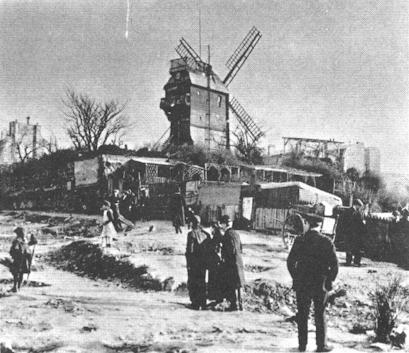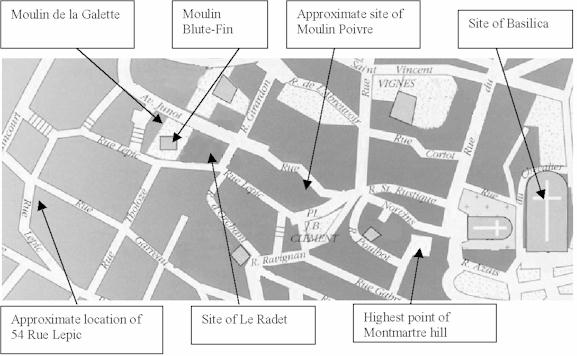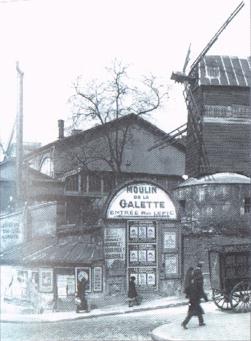
![]()
Vincent's Windmills of Montmartre
A study of the mills painted and drawn by the artist while he was living in Paris.
By Bob Harrison
In Medieval times there were many windmills gracing the skyline of Paris, grinding out a constant supply of flour to feed the population of the city. At the time of Van Gogh's brief stay in Paris from 1886 to 1888 there were at least four of them still standing in Montmartre, one of which was the notorious Moulin Rouge. Since this mill was situated at the bottom of the hill on the Boulevard de Clichy, close to the corner of rue Lepic, it does not enter into our considerations, since although Lautrec painted and frequented this cabaret, Vincent himself apparently never considered it as a subject.
So we are left with only three windmills to attempt to identify.
Over the years their individual names seem to have become jumbled together with the name "Moulin de la Galette," which was actually the name of the café-concert built around them. The de la Faille catalogue is particularly at fault here; even the correct identification of the Moulin Radet for one of the paintings is questioned. The true names of the individual mills, from west to east, were: the Blute-Fin, the Radet and the Debray or Poivre.
The Debray family had come into possession of the farmland and the windmills in about 1810. The area around the Blute-Fin mill had been converted into a dance hall and drinking establishment, partly in the open air and partly indoors. This entire complex, built around and including the Blute-Fin windmill, was known as the Moulin de la Galette. To get some idea of what it looked like inside, see the Renoir "Dance Hall at the Moulin de la Galette," at the Musée d'Orsay which shows an exterior scene, and Picasso's 1900 interior "La Moulin de la Galette" at the Guggenheim Museum, NY.
The windmills are fairly easy to identify, since each one had distinct external differences. The Blute-Fin was the largest one, and, by Vincent's time, had a balcony built on its roof cap; this was used as an observation point where people could go to see the city (on days when the industrial smoke and haze did not obscure the view). It was also the only mill still possessing complete sails, or at least the full ribs of them, and the only one that could still be rotated about its vertical axis. The other two mills just retained the main splines of their sails, which appear as simple bars against the sky.

Moulin Blute-Fin, looking in an east-south-east direction, about 1910. The photographer was standing on the Avenue Junot, and the buildings of the "Galette" are clustered around the base of the mill. The partly finished Basilica Sacré-Coeur can be seen on the skyline at the left side of the photo.
The Radet was situated some one hundred meters eastward, on the corner of rue Lepic and rue Girardon, and appears to have been permanently fixed upon its base pivot, so that its sails always faced south. These sails appear to be fixed in an X position in all the photos and Vincent's works. The close proximity of buildings erected close to the mill rendered any axial rotation impossible, and it would have been extremely dangerous for the sails themselves to be allowed to turn.

There are some excellent old photographs of the Radet mill in existence, which allow us to give a positive identity to Vincent's depictions of it. A reconstructed empty carcass of the mill still stands today on rue Lepic, but now the sails are reduced to a single horizontal bar.

The Moulin Radet, photographed from a vantage point on rue Lepic, looking westward, with the rue Girardon sloping upwards to the right, where the wagon is.Note that the sign indicates that the entrance to the "Galette" is on rue Lepic, with a left-pointing arrow. This structure under the sign was the former entrance to the Moulin de la Galette, which would explain its redirection purpose. On the skyline to the left, the sails and roof of the Blute-Fin can be discerned.
Finally the Poivre mill was the smallest of the three mills, the structure was quite noticeably narrower, and it was some distance east of the others. It appears to have had its sails fixed in a vertical cross, like a 'plus' sign. While the first two mills still stand (or rather poor replicas of them), the Poivre has long disappeared.
It is odd that no signs of the construction of the basilica of the Sacré Coeur can be seen in any of Vincent's works. It is situated in the same area as the Poivre, and construction had been underway since 1875, so it should have been visible by 1886, although the builders had run into some major problems with the foundations, and it wasn't finally completed until after the First World War, in 1919. The stone quarry visible in many of the paintings was probably a source of construction stone for the basilica.
Works showing all three mills.
Works showing two mills.
Works showing the Blute-Fin.
Works showing the Radet.
Works showing the Poivre.
 Return to Visitor Submissions page
Return to Visitor Submissions page
 Return to main Van Gogh Gallery page
Return to main Van Gogh Gallery page